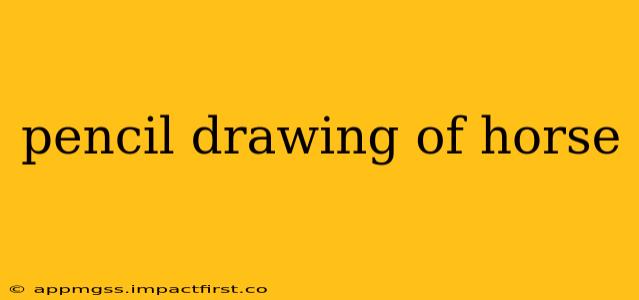Creating a compelling pencil drawing of a horse requires more than just skill; it demands understanding, patience, and a keen eye for detail. This guide delves into the process, from initial sketching to achieving realistic shading and texture, helping you capture the majestic spirit of the equine subject. Whether you're a seasoned artist or a beginner picking up a pencil for the first time, this comprehensive guide will equip you with the knowledge and techniques to create stunning horse portraits.
What Materials Do I Need for a Pencil Drawing of a Horse?
The right tools significantly impact the final outcome. While you can achieve excellent results with basic materials, investing in quality supplies enhances your experience and the quality of your artwork.
- Pencils: A variety of graded pencils is essential. A hard pencil (like a 2H or H) is ideal for light sketching and outlining, while softer pencils (2B, 4B, 6B, and even 8B) allow for darker shading and detail work. Experiment to find your preferred grades.
- Eraser: A kneaded eraser provides flexibility, allowing you to lift graphite precisely without damaging the paper. A vinyl eraser is useful for larger corrections.
- Blending Stumps: These tools help smoothly blend graphite for subtle transitions between light and shadow, adding depth to your drawing. Tortillons are similar but slightly pointed, allowing for finer detail work.
- Paper: Choose a paper with a slightly textured surface that will hold the graphite well. Heavier weight paper (at least 110lb/160gsm) is recommended to prevent tearing.
- Reference Image: A high-quality photograph or a real-life horse provides crucial guidance. Choose an image that clearly shows the horse's anatomy and features.
How Do I Start Sketching a Horse?
Begin with a light outline using a hard pencil. Don't worry about perfection at this stage; focus on capturing the horse's basic proportions and posture. Break the horse's body down into simple shapes – circles, squares, and lines – to establish the underlying structure.
Understanding Horse Anatomy:
This is crucial for a realistic drawing. Study the horse's skeletal structure and musculature. Pay attention to the proportions of the head, neck, body, and legs. Understanding the anatomy ensures your drawing accurately represents the horse's form.
How Do I Add Shading and Detail to My Horse Drawing?
Once your basic sketch is complete, gradually build up the shading using your softer pencils. Start with lighter shades and gradually add darker tones to create depth and dimension. Consider the light source and how it affects the horse's form, creating highlights and shadows.
Creating Realistic Textures:
Horses have various textures – smooth skin, coarse mane and tail, etc. Use different pencil techniques to capture these textures. For example, short, light strokes can suggest the texture of the horse's coat, while longer, more fluid strokes can capture the flow of its mane.
What Are Some Common Mistakes to Avoid When Drawing a Horse?
- Ignoring proportions: Accurately representing the horse's proportions is vital. Careful observation and practice are key to avoiding this common pitfall.
- Over-blending: While blending is important, over-blending can lead to a muddy, indistinct drawing. Maintain some texture and definition in your shading.
- Neglecting details: Pay attention to the small details – eyes, nostrils, mane, and tail – to bring your drawing to life.
- Lack of reference: Working without a good reference image makes it challenging to accurately capture the horse's form and features.
How Can I Improve My Horse Drawing Skills?
Practice is essential! Start with simpler poses and gradually move on to more complex ones. Study the work of other artists for inspiration and learn from their techniques. Consider taking a life drawing class to improve your observation skills.
Practicing Different Poses and Angles:
Experiment with drawing horses in various poses – running, galloping, standing, lying down – to broaden your skills and understanding of their anatomy in motion.
This guide provides a foundational understanding of creating a pencil drawing of a horse. Remember that practice and patience are key to mastering this art form. Embrace the learning process, and you'll steadily enhance your ability to capture the beauty and power of these magnificent animals on paper.
